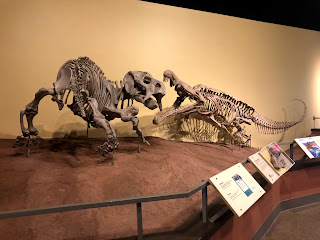Saturday, February 9, 2019
Albuquerque Museum of Natural History
Lori and I hit the Albuquerque Museum of Natural History twice. The first time was with a childhood friend who now lives in Rio Rancho and his grandson. The second time it was just us and we did more of the boring adult stuff. The museum is in the Old Town area of the city so plan carefully since the Old Town historic district is a fascinating place all by itself. There are several museums in this area so plan on spending three or four days just in Old Town. The New Mexico Museum of Natural History and Science was founded in 1986. It operates as a public revenue facility of the New Mexico Department of Cultural Affairs. The exterior of the museum features "A Walk Through New Mexico," a landscape representation of the topographical and geologic features of New Mexico. The first thing to great you to the Museum are two life-size New Mexico dinosaurs created by Albuquerque sculptor Dave Thomas. This is a pretty impressive welcome from a relatively young museum. The Museum's permanent exhibit halls illustrate a journey through time, covering the birth of the Universe (≈13.6 billion years ago) to the Ice Age (≈10,000 years ago). The “journey through time halls” are as follows:
Origins - How and why did life on Earth emerge? New research taking place around the globe-including here in New Mexico-suggests we are close to answering this question.
The Bisti Beast - Western North America is famous for its dinosaur fossils. Many of these come from the San Juan Basin of northwestern New Mexico. Most of these specimens were collected in the early part of the 20th century and the resulting specimens were shipped to Museums far from New Mexico. However, since the New Mexico Museum of Natural History and Science opened in 1986, newly discovered specimens have been found and kept within the state.
T. Rex Attack! - You find yourself face to face with the gaping maw of the second largest T. rex ever found, in full attack mode, as they round the corner of the Museum Atrium. Stan is a Tyrannosaurus rex, one of the largest predatory dinosaurs of all time. He was a powerful, agile, bipedal killing machine. Forty feet long and 12 feet high at the hips, Stan weighed roughly 6 tons and hunted with an acute sense of smell, 3-D vision, and great speed powered by huge and muscular hind legs.
The Hall of the Stars – This exhibit is a Winner of the 2014 Gold MUSE Award for Interpretive Interactive Installations. The Hall of the Stars aims to explain how the night sky is organized. Though the project had some effort from museum employees, it was almost entirely accomplished by museum volunteers and members the professional astronomical community. This exhibit encourages you to explore the sky at their own pace and learn many different astronomical concepts, from the changing of the seasons to types of deep sky objects that you can see from your own backyard.
The Fossilworks exhibit shows people (mostly trained volunteers!) removing material from fossilized dinosaur bones. The museum also houses a "Naturalist Center" that is home to live animals and insects, and there is also a geologic exhibit on the minerals of the region.
While I may be the exception because I go to these museums for the astronomy and space exhibits; I would venture that most go to natural history museums for the dinosaurs. This museum will not disappoint you. The Jurassic Super Giants exhibit features the complete skeletons of Seismosaurus, Saurophaganax, Stegosaurus, and one leg of a Brachiosaurus. In the museum's atrium is the skeleton of Stan, a Tyrannosaurus rex measuring forty feet in length and twelve feet in height, the second largest T. rex ever found.
Bronze statues of two dinosaurs created by artist David A. Thomas, a Pentaceratops named "Spike" and an Albertosaurus named "Alberta", stand at the entrance. Spike and Alberta were installed at the museum in the mid-1980's, with Spike being put in place in 1985 and Alberta joining a few years later in 1987. Many dinosaur fossils have been found in New Mexico, and a few of the ones on display in the museum are only known from New Mexico.
The Museum also houses changing exhibits, the Hope Cafe, NatureWorks Discovery Store, as well as the Dynatheater, which is a 3-D theater similar to IMAX. The films shown are typically documentary style, focusing on a broad range of subjects.
Subscribe to:
Post Comments (Atom)






No comments:
Post a Comment